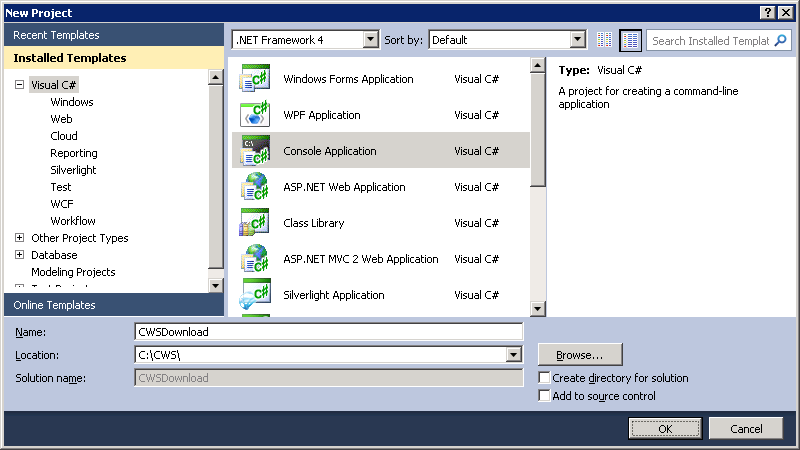Downloading Documents (C#)
This tutorial walks you through all the steps needed to start downloading documents from Content Server using the CWS API with C# and Visual Studio.
Outline
Setup Your Project
The first thing you need to do is create a new project. In your project you need to add a service reference for CWS and point it to each service we will use. In this sample we will use the following services:
- Authentication
- ContentService
- DocumentManagement
Create a New Project
-
Open Visual Studio.
-
Open the File menu and select New → Project... (Ctrl + Shift + N).
-
Select Visual C# as the project type, select Console Application as the project template, enter a name for the project, and then select OK.
Add a Service Reference
Next, we need to add a service reference for CWS and point it to each service we want to use. For this sample we need to use the following services:
- Authentication
- ContentService
- DocumentManagement
-
Open the Project menu and select Add Service Reference...
-
Enter the URL of the Authentication service in the Address box and select Go.
-
Enter
CWSas the namespace and select OK. -
Open the Project menu and make sure the Show All Files option is selected. In the Solution Explorer, open the Service References → CWS → Reference.svcmap file.
-
Add a new
MetadataSourceelement for each one of the services we need to use.... <MetadataSources> <MetadataSource Address="http://localhost/cws/Authentication.svc" Protocol="http" SourceId="1" /> <MetadataSource Address="http://localhost/cws/ContentService.svc" Protocol="http" SourceId="2" /> <MetadataSource Address="http://localhost/cws/DocumentManagement.svc" Protocol="http" SourceId="3" /> </MetadataSources> ...
-
In the Solution Explorer, select the CWS service reference under the Service References folder. In the Project menu select Update Service Reference.
Modify the Service Configuration Settings
After you add a service reference you will see that an app.config file gets added to your project. The app.config file is simply just a configuration file for your application. For this sample we will make a few changes to the app.config file to change the default behaviour of the services.
-
Change the ContentService binding
transferModetoStreamed.This setting indicates whether a channel uses streamed or buffer modes for the transfer of messages. Setting the transferMode to Streamed for the ContentService binding will allow the message body to be read in smaller portions.
-
Change the ContentService binding
maxReceivedMessageSizeto2147483648(2 GB).This setting indicates the maximum size, in bytes, of a message that can be recieved. Setting the maxReceivedMessageSize to 2147483648 for the ContentService binding will allow for downloading files up to 2 GB.
<binding name="BasicHttpBinding_ContentService" closeTimeout="00:01:00" openTimeout="00:01:00" receiveTimeout="00:10:00" sendTimeout="00:01:00" allowCookies="false" bypassProxyOnLocal="false" hostNameComparisonMode="StrongWildcard" maxBufferSize="65536" maxBufferPoolSize="524288" maxReceivedMessageSize="2147483648" messageEncoding="Mtom" textEncoding="utf-8" transferMode="Streamed" useDefaultWebProxy="true"> <readerQuotas maxDepth="32" maxStringContentLength="8192" maxArrayLength="16384" maxBytesPerRead="4096" maxNameTableCharCount="16384" /> <security mode="None"> <transport clientCredentialType="None" proxyCredentialType="None" realm="" /> <message clientCredentialType="UserName" algorithmSuite="Default" /> </security> </binding>
Write Your Code
-
The first step is to authenticate a user. This sample uses basic Content Server authentication. The authentication token will be used by the other service clients. You will need to change the
usernameandpasswordto use valid credentials of a user on your system.// The user's credentials string username = "username"; string password = "password"; // Create the Authentication service client AuthenticationClient authClient = new AuthenticationClient(); // Store the authentication token string authToken = null; // Call the AuthenticateUser() method to get an authentication token try { Console.Write("Authenticating User..."); authToken = authClient.AuthenticateUser(username, password); Console.WriteLine("Success!\n"); } catch (FaultException e) { Console.WriteLine("Failed!"); Console.WriteLine("{0} : {1}\n", e.Code.Name, e.Message); return; } finally { // Always close the client authClient.Close(); }
-
Next, store the metadata for the download in a method context on the server. You will need to change the
documentIDto an ID of a document on your system.// The ID of the document to download int documentID = 5631; // Create the DocumentManagement service client DocumentManagementClient docManClient = new DocumentManagementClient(); // Create the OTAuthentication object and set the authentication token OTAuthentication otAuth = new OTAuthentication(); otAuth.AuthenticationToken = authToken; // Store the context ID for the download string contextID = null; // Call the GetVersionContentsContext() method to create the context ID try { Console.Write("Generating context ID..."); contextID = docManClient.GetVersionContentsContext(ref otAuth, documentID, 0); Console.WriteLine("Success!\n"); } catch (FaultException e) { Console.WriteLine("Failed!"); Console.WriteLine("{0} : {1}\n", e.Code.Name, e.Message); return; } finally { // Always close the client docManClient.Close(); }
-
Finally, download the file using the
contextIDfrom before. You can change thefilePathvalue to download the file to a different location, if needed.// The local file path to download the document to string filePath = @"C:\temp\test.pdf"; // Create the ContentService service client ContentServiceClient contentServiceClient = new ContentServiceClient(); // Create a stream to download the file with Stream downloadStream = null; // Call the DownloadContent() method to get the download stream try { Console.Write("Downloading file..."); downloadStream = contentServiceClient.DownloadContent(ref otAuth, contextID); } catch (FaultException e) { Console.WriteLine("Failed!"); Console.WriteLine("{0} : {1}\n", e.Code.Name, e.Message); return; } finally { // Always close the client contentServiceClient.Close(); } // Create a file stream to write the contents to the local file FileStream fileStream = null; try { fileStream = new FileStream(filePath, FileMode.Create); // Create a buffer to read the download stream into (buffer size = 4 KB) byte[] buffer = new byte[4096]; // Keep track of the size of the file long fileSize = 0; // Read the contents from download stream and write them to the file stream for (int read = downloadStream.Read(buffer, 0, buffer.Length); read > 0; read = downloadStream.Read(buffer, 0, buffer.Length)) { fileStream.Write(buffer, 0, read); fileSize += read; } Console.WriteLine("Success!\n"); Console.WriteLine("Downloaded {0} bytes to {1}.\n", fileSize, filePath); } catch (Exception e) { Console.WriteLine("Failed!"); Console.WriteLine("{0}\n", e.Message); return; } finally { // Always close the streams if (fileStream != null) { fileStream.Close(); } downloadStream.Close(); }
Run the Program
If everything is setup correctly you should be able to successfully run the program. You can double check that everything worked by looking at the downloaded document on your local file system.


